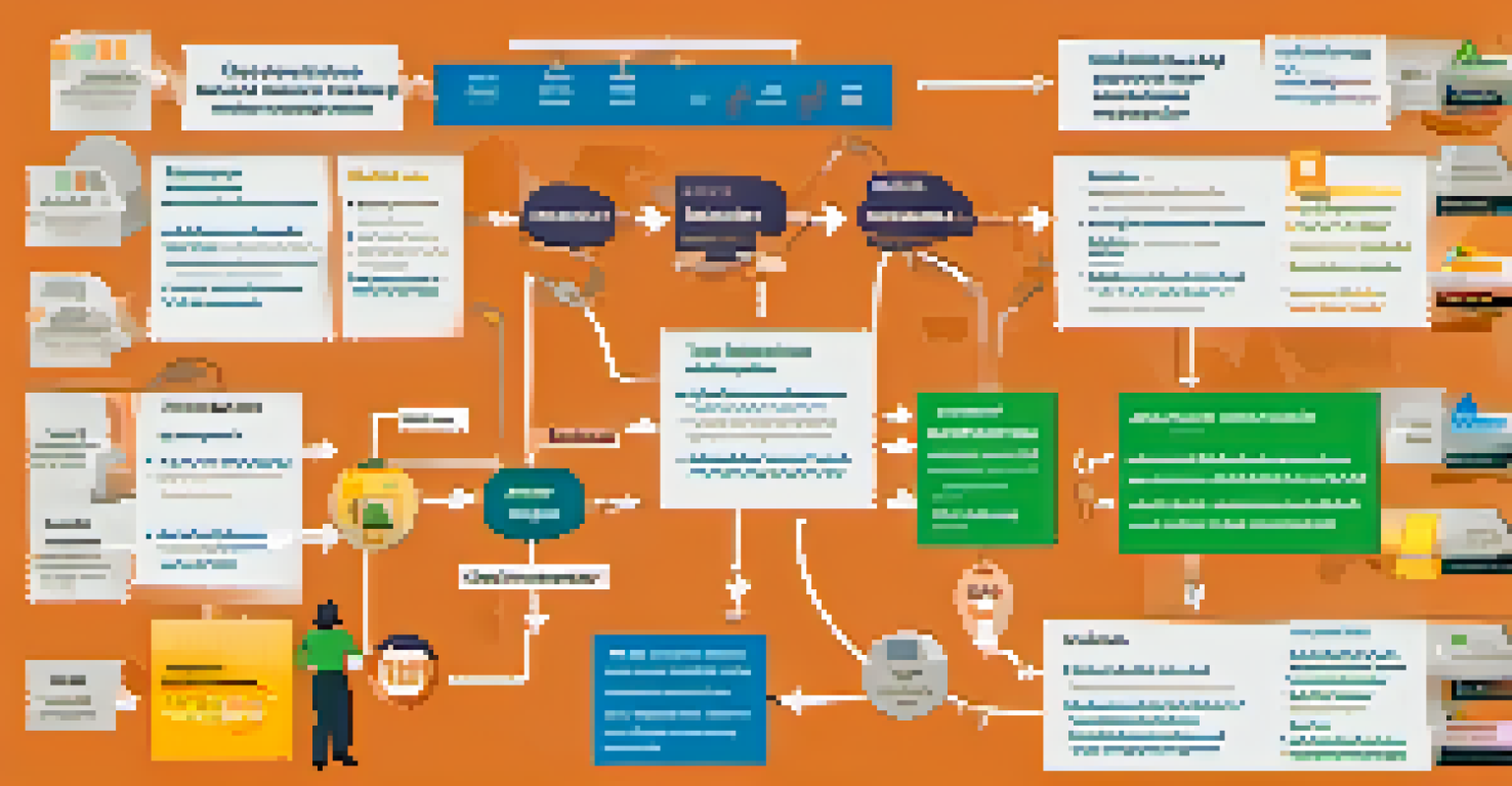Crisis Communication Strategies in Business Continuity

Understanding Crisis Communication in Business Continuity
Crisis communication is a key component of business continuity planning. It involves sharing timely and accurate information during a disruptive event, ensuring stakeholders remain informed and engaged. By effectively managing communication, businesses can maintain trust and mitigate potential damage to their reputation. Understanding this process helps organizations prepare for unexpected challenges, whether natural disasters or internal crises.
In the midst of chaos, there is also opportunity.
The goal of crisis communication is to provide clear messaging that addresses the concerns of employees, customers, and the public. This clarity is vital as it fosters a sense of security and control amidst uncertainty. For instance, companies that communicate transparently during a crisis can often retain customer loyalty despite challenges. It's all about making sure everyone knows what’s happening and what steps are being taken.
Furthermore, a well-crafted crisis communication plan can significantly reduce confusion and misinformation. This is especially important in today's digital age, where news spreads rapidly. By having a strategy in place, businesses can control the narrative and provide consistent updates, ultimately supporting their overall business continuity efforts.
Identifying Key Stakeholders for Crisis Communication
Identifying key stakeholders is crucial for effective crisis communication. Stakeholders can include employees, customers, suppliers, investors, and the media. Understanding who your key audiences are helps tailor your messaging for maximum impact. For example, employees may need different information than customers regarding operational changes during a crisis.

It's essential to prioritize these groups based on their needs and the nature of the crisis. A well-defined stakeholder map can assist businesses in determining who should receive information first. By addressing the most affected parties, organizations can ensure that their communication is relevant and timely.
Crisis Communication is Essential
Effective crisis communication helps maintain trust and mitigates reputational damage during disruptive events.
Moreover, engaging with stakeholders during a crisis fosters goodwill and strengthens relationships. For instance, a company that proactively updates its customers about service disruptions can enhance customer loyalty. This approach not only keeps everyone informed but also shows that the organization values its stakeholders' concerns.
Developing a Clear Communication Plan for Crises
A clear communication plan is essential for navigating crises effectively. This plan should outline key messages, preferred communication channels, and designated spokespersons. Having a structured approach allows organizations to respond swiftly and coherently when a crisis strikes. For example, if a tech company experiences a data breach, a well-prepared plan can streamline their response.
The single biggest problem in communication is the illusion that it has taken place.
Additionally, the communication plan should include protocols for various scenarios. This means considering different types of crises and preparing tailored messages for each situation. A one-size-fits-all approach rarely works in times of crisis, so flexibility and specificity are key.
Regularly reviewing and updating the plan is also important. As businesses evolve, so do potential risks and stakeholder needs. By continuously refining their communication strategies, organizations can ensure they're ready to tackle any crisis head-on.
Crafting Key Messages for Crisis Situations
Crafting key messages during a crisis is about clarity, empathy, and transparency. It's crucial to communicate what happened, the impact on stakeholders, and the steps being taken to resolve the issue. For instance, a retail company facing a supply chain disruption should clearly outline how it affects product availability and what customers can expect moving forward.
Empathy in messaging helps to humanize the organization during difficult times. Acknowledging the challenges stakeholders face builds connections and demonstrates the company's commitment to their well-being. This approach can turn a potential negative experience into an opportunity to reinforce brand loyalty.
Engage Stakeholders for Impact
Identifying and prioritizing key stakeholders ensures that tailored messaging reaches those most affected by a crisis.
Lastly, consistency is vital when delivering key messages. Any discrepancies can lead to confusion and mistrust. By ensuring that all communications align with the established key messages, organizations can maintain credibility and reassure stakeholders throughout the crisis.
Utilizing Multiple Channels for Crisis Communication
In our digital age, utilizing multiple channels for communication during a crisis is essential. Relying on just one platform can leave gaps in information dissemination. For instance, combining social media, email, and traditional media can help reach a broader audience. Each channel has its strengths, and leveraging them effectively can enhance message visibility.
Moreover, different stakeholders may prefer different channels. Some might favor social media for real-time updates, while others may prefer emails for detailed information. By diversifying communication channels, organizations can cater to varying preferences and ensure that their messages resonate with all audiences.
It's also important to maintain a consistent tone and message across all channels. This not only reinforces the key messages but also helps create a unified brand voice during a crisis. A cohesive approach builds trust and reliability, essential components of effective crisis communication.
Monitoring and Responding to Stakeholder Feedback
Monitoring stakeholder feedback during a crisis is crucial for adjusting communication strategies. Social media platforms and customer service channels are often the first places people express their concerns or seek information. By actively listening to feedback, organizations can gauge public sentiment and modify their messaging accordingly. For example, if customers express confusion about a product recall, clearer communications may be needed.
In addition to monitoring feedback, responding in a timely manner is equally important. Quick responses can mitigate potential backlash and show stakeholders that their concerns are being taken seriously. This responsiveness fosters a sense of trust and transparency, both critical during uncertain times.
Evaluate and Improve Strategies
Post-crisis evaluations are vital for refining communication strategies and enhancing preparedness for future challenges.
Ultimately, engaging with stakeholders and addressing their feedback can help organizations refine their crisis communication strategies. By understanding what resonates with their audience, businesses can improve their approach not just during crises but also in everyday communications.
Evaluating Crisis Communication Effectiveness Post-Crisis
Once a crisis has passed, evaluating the effectiveness of the communication strategies employed is essential. This evaluation helps identify what worked well and what could be improved for future crises. Gathering feedback from stakeholders post-crisis can provide valuable insights into their perceptions of the communication process.
Metrics such as response times, message clarity, and stakeholder engagement are important to analyze. For example, if stakeholders felt well-informed and reassured, it’s a good sign that the strategy was effective. Conversely, if there were significant gaps in communication, those should be addressed in future planning.

Regular evaluations contribute to a culture of continuous improvement. By learning from each crisis, organizations can enhance their communication plans, ensuring they are better prepared for whatever comes next. This proactive approach not only strengthens resilience but also fosters confidence among stakeholders.
Building a Culture of Preparedness for Future Crises
Building a culture of preparedness is vital for managing future crises effectively. This involves training employees on crisis communication protocols and encouraging open discussions about potential risks. When employees understand their roles in a crisis, they can respond more confidently and effectively, which is reassuring for all stakeholders involved.
Moreover, conducting regular drills and simulations can help reinforce these strategies. Just like a fire drill prepares everyone for an actual emergency, crisis communication drills can ensure everyone knows how to respond when the unexpected happens. This practice helps identify potential weaknesses in the communication plan and allows for adjustments before a real crisis arises.
Ultimately, fostering a culture of preparedness not only enhances crisis response but also builds a resilient organization. When employees feel empowered to handle crises, it reflects positively on the company as a whole. This proactive mindset can transform challenges into opportunities for growth and improvement.